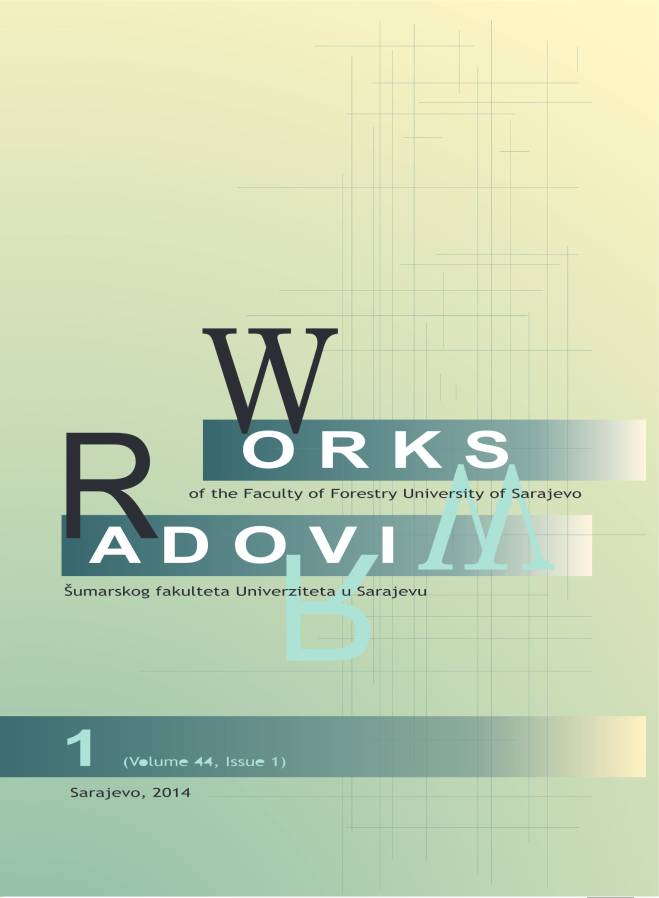MORPHOLOGICAL IDENTIFICATION OF NOTHOSPECIES ALNUS X PUBESCENS TAUSCH. AND THEIR NEW LOCALITIES IN CENTRAL BOSNIA
DOI:
https://doi.org/10.54652/rsf.2014.v44.i1.103Keywords:
alder, morphometry, natural hybridization, sympatry, variationAbstract
UDK: 582.632.1:581.45(497.6)
Natural interspecies hybrids of black (Alnus glutinosa (L.) Gaertn) and grey (A. incana (L.) Moench) alder are not frequent in nature but they are registered, and according to modern systematic nomenclature are classified within nothospecies A. × pubescens Tausch.. Since the presence of spontaneous intermediate forms of the genus Alnus in Bosnia and Herzegovina is insufficiently explored, the first results of comparative morphological analysis (seven leaf’s characters) of black and grey alder and their hybrids are given in this study. About 10% of hybrid individuals were present in the studied sympatric populations, and they had more heterogeneous leaves than parental species. Good diagnostic characters showed intermediate values in comparison to the parental species, which are: number of pairs of lateral veins, angle from the top of the leaflet to the top of the upper 3rd nerve, and distance from the top of the leaflet to the top of the upper 3rd vein. According to analyzed characters, hybrids either hold intermediate positions between the parental species or are closer to the maternal species (A. incana). Three new findings of nothospecies A. × pubescens for Flora B&H are rivers’ localities Drinjača near Kladanj, Turbe near Travnik, and Stavnja near Vareš. Due to the low frequency of observed individuals of A. x pubescens, they are vulnerable and require special measures of protection and biodiversity conservation activities of autochthonous gene pool, it is necessary to determine the actual state in all previously published hybrid complexes’ findings and expand researches in B&H in the coming period.
Downloads
References
BALL P.W. (1964): Alnus. In: Tutin T.G. et al. (Eds.), Flora Europaea, University Press, Cambridge, pp. 59.
BANAEV E.V. (1997): Variation in quantitative characters of leaves and female cones in Alnus hirsuta (Betulaceae). Bot. Zh. 82(6): 86–91.
BANAEV E.V., BAŽANT V. (2007): Study of natural hybridization between Alnus incana (L.) Moench. and Alnus glutinosa (L.) Gaertn. Journal of Forest Science 53:66-73.
BANAEV E.V. (2009): On the effect of climate on the morphological structure of Alnus hirsute (Betulaceae). Russian Journal of Ecology 40(1): 18–23.
BECK G.V.M. (1907): Alnus. In: Beck G.V.M. (ed), Flora Bosne, Hercegovine i Novopazarskog sandžaka, II dio, Zemaljska štamparija, Sarajevo, pp. 101-102.
BOUSGUET I., CHELIAR W.M., LALONDE M. (1989): Allozyme divergence and introgressive hybridization between Alnus crispa and Alnus sinuate (Betulaceae). American Journal of Botany 76: 228-229.
BOUSQUET J., CHELIAK W.M., WANG J., LALONDE M. (1990): Genetic divergence and introgressive hybridization between Alnus sinuata and A. crispa Betulaceae. Plant Systematics and Evolution 170: 107-124.
FUKAREK P. (1959): Pregled dendroflore Bosne i Hercegovine. Narodni šumar, Sarajevo, XIII(5-6): 263-286.
FUKAREK P. (1962): Neka neriješena pitanja u dosadašnjim dendrološkim i dendrogeografskim istraživanjima u Bosni i Hercegovini. Narodni šumar, Sarajevo, XVI (7-9): 357-373.
FURLOW J.J. (1979): The systematic of the American species of Alnus (Betulaceae). Rhodora 81: 1-21, 151-248.
HALL R.B., BURGESS D. (1990): Evaluation of Alnus species and hybrids. Biomass 22: 21-34.
HYLANDER N. (1957): On cut-leaved and small-leaved forms of Alnus glutinosa and A. incana. Svensk Botanisk Tidskrift 51: 437-453.
LAKUŠIĆ R. (1980): Ekologija biljaka. IGKRO Svjetlost, Sarajevo, pp. 90-95.
OBERDORFER E. (1994): Pflanzen-soziologische Exkursionflora. Verlag Eugen Ulmer, Stuttgart.
PARFENOV V.I. (1980): Dependence of distribution and adaptation of plant species on the area borders. Minsk, Nauka i tekhnika: 205.
PARNELL J. (1994): Variation and hybridisation of Alnus Miller in Ireland. Watsonia 20: 67-70.
RADULOVIĆ J.V., STEFANOVIĆ V. (1971): Ekološke i azotofiksacione osobine joha. Godišnjak Biološkog instituta Univerziteta u Sarajevu, Svjetlost, Sarajevo, XXIV: 161-178.
STEELE F.L. (1961): Introgression of Alnus serrulata and Alnus rugosa. Rhodora 63: 297-304.
ŠOLJAN D. (1987): Varijabilnost morfoloških karaktera lista crne johe /Alnus glutinosa (L.) Gaertn./. Godišnjak Biološkog instituta Univerziteta u Sarajevu, Sarajevo, 40: 101-115.
THE PLANT LIST (2013): Version 1.1. Published on the Internet; http://www.theplantlist.org/ (accessed 24.03.2014.).
TOMIĆ Z., RAKONJAC LJ. (2013): Šumske fitocenoze Srbije. Univerzitet Singidunum, Fakultet za primjenjenu ekologiju Futura, Beograd.
VANDEN HEUVEL B.D. (2011): Alnus. IN: Kole C. (ed.), Wild crop relatives: genomic and breeding resources, Forest Trees, Springer-Verlag Berlin Heidelberg, DOI 10.1007/978-3-642-21250-5_1.
VUKELIĆ J. (2012): Šumska vegetacija Hrvatske. Šumarski fakultet Sveučilišta u Zagrebu, Državni zavod za zaštitu prirode, Zagreb.
VUKIĆEVIĆ E., JOVANOVIĆ B. (1983): Prilog taksonomskom proučavanju crne i bele jove u okolini Sjenice. Glasnik Šumarskog fakulteta 61, Univerzitet u Beogradu - Šumarski fakultet, Beograd: 1-14.






















